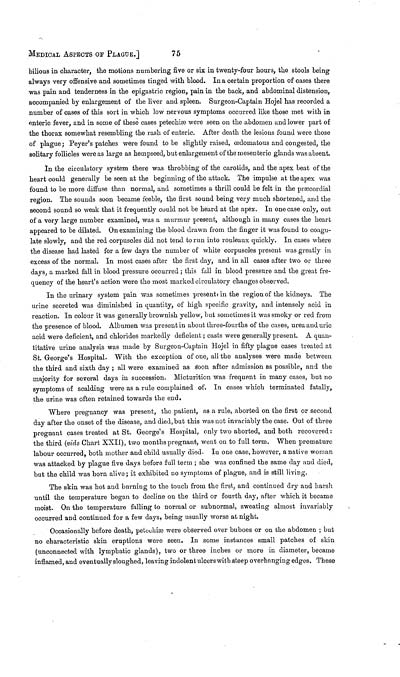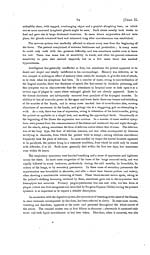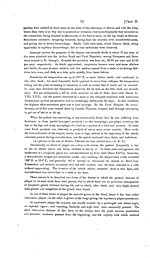Medicine - Disease > Bombay plague: being a history of the progress of plague in the Bombay presidency from September 1896 to June 1899
(105) Page 75
Download files
Individual page:
Thumbnail gallery: Grid view | List view

MEDICAL ASPECTS OF PLAGUE.] 75
bilious in character, the motions numbering five or six in twenty-four hours, the stools being
always very offensive and sometimes tinged with blood. In a certain proportion of cases there
was pain and tenderness in the epigastric region, pain in the back, and abdominal distension,
accompanied by enlargement of the liver and spleen. Surgeon-Captain Hojel has recorded a
number of cases of this sort in which low nervous symptoms occurred like those met with in
enteric fever, and in some of these cases petechi were seen on the abdomen and lower part of
the thorax somewhat resembling the rash of enteric. After death the lesions found were those
of plague; Peyer's patches were found to be slightly raised, domatous and congested, the
solitary follicles were as large as hempseed, but enlargement of the mesenteric glands was absent.
In the circulatory system there was throbbing of the carotids, and the apex beat of the
heart could generally be seen at the beginning of the attack. The impulse at the apex was
found to be more diffuse than normal, and sometimes a thrill could be felt in the prcordial
region. The sounds soon became feeble, the first sound being very much shortened, and the
second sound so weak that it frequently could not be heard at the apex. In one case only, out
of a very large number examined, was a murmur present, although in many cases the heart
appeared to be dilated. On examining the blood drawn from the finger it was found to coagu-
late slowly, and the red corpuscles did not tend to run into rouleaux quickly. In cases where
the disease had lasted for a few days the number of white corpuscles present was greatly in
excess of the normal. In most cases after the first day, and in all cases after two or three
days, a marked fall in blood pressure occurred; this fall in blood pressure and the great fre-
quency of the heart's action were the most marked circulatory changes observed.
In the urinary system pain was sometimes present in the region of the kidneys. The
urine secreted was diminished in quantity, of high specific gravity, and intensely acid in
reaction. In colour it was generally brownish yellow, but sometimes it was smoky or red from
the presence of blood. Albumen was present in about three-fourths of the cases, urea and uric
acid were deficient, and chlorides markedly deficient; casts were generally present. A quan-
titative urine analysis was made by Surgeon-Captain Hojel in fifty plague cases treated at
St. George's Hospital. With the exception of one, all the analyses were made between
the third and sixth day; all were examined as soon after admission as possible, and the
majority for several days in succession. Micturition was frequent in many cases, but no
symptoms of scalding were as a rule complained of. In cases which terminated fatally,
the urine was often retained towards the end.
Where pregnancy was present, the patient, as a rule, aborted on the first or second
day after the onset of the disease, and died, but this was not invariably the case. Out of three
pregnant cases treated at St. George's Hospital, only two aborted, and both recovered:
the third (vide Chart XXII), two months pregnant, went on to full term. When premature
labour occurred, both mother and child usually died. In one case, however, a native woman
was attacked by plague five days before full term; she was confined the same day and died,
but the child was born alive; it exhibited no symptoms of plague, and is still living.
The skin was hot and burning to the touch from the first, and continued dry and harsh
until the temperature began to decline on the third or fourth day, after which it became
moist. On the temperature falling to normal or subnormal, sweating almost invariably
occurred and continued for a few days, being usually worse at night.
Occasionally before death, petechi were observed over buboes or on the abdomen; but
no characteristic skin eruptions were seen. In some instances small patches of skin
(unconnected with lymphatic glands), two or three inches or more in diameter, became
inflamed, and eventually sloughed, leaving indolent ulcers with steep overhanging edges. These
bilious in character, the motions numbering five or six in twenty-four hours, the stools being
always very offensive and sometimes tinged with blood. In a certain proportion of cases there
was pain and tenderness in the epigastric region, pain in the back, and abdominal distension,
accompanied by enlargement of the liver and spleen. Surgeon-Captain Hojel has recorded a
number of cases of this sort in which low nervous symptoms occurred like those met with in
enteric fever, and in some of these cases petechi were seen on the abdomen and lower part of
the thorax somewhat resembling the rash of enteric. After death the lesions found were those
of plague; Peyer's patches were found to be slightly raised, domatous and congested, the
solitary follicles were as large as hempseed, but enlargement of the mesenteric glands was absent.
In the circulatory system there was throbbing of the carotids, and the apex beat of the
heart could generally be seen at the beginning of the attack. The impulse at the apex was
found to be more diffuse than normal, and sometimes a thrill could be felt in the prcordial
region. The sounds soon became feeble, the first sound being very much shortened, and the
second sound so weak that it frequently could not be heard at the apex. In one case only, out
of a very large number examined, was a murmur present, although in many cases the heart
appeared to be dilated. On examining the blood drawn from the finger it was found to coagu-
late slowly, and the red corpuscles did not tend to run into rouleaux quickly. In cases where
the disease had lasted for a few days the number of white corpuscles present was greatly in
excess of the normal. In most cases after the first day, and in all cases after two or three
days, a marked fall in blood pressure occurred; this fall in blood pressure and the great fre-
quency of the heart's action were the most marked circulatory changes observed.
In the urinary system pain was sometimes present in the region of the kidneys. The
urine secreted was diminished in quantity, of high specific gravity, and intensely acid in
reaction. In colour it was generally brownish yellow, but sometimes it was smoky or red from
the presence of blood. Albumen was present in about three-fourths of the cases, urea and uric
acid were deficient, and chlorides markedly deficient; casts were generally present. A quan-
titative urine analysis was made by Surgeon-Captain Hojel in fifty plague cases treated at
St. George's Hospital. With the exception of one, all the analyses were made between
the third and sixth day; all were examined as soon after admission as possible, and the
majority for several days in succession. Micturition was frequent in many cases, but no
symptoms of scalding were as a rule complained of. In cases which terminated fatally,
the urine was often retained towards the end.
Where pregnancy was present, the patient, as a rule, aborted on the first or second
day after the onset of the disease, and died, but this was not invariably the case. Out of three
pregnant cases treated at St. George's Hospital, only two aborted, and both recovered:
the third (vide Chart XXII), two months pregnant, went on to full term. When premature
labour occurred, both mother and child usually died. In one case, however, a native woman
was attacked by plague five days before full term; she was confined the same day and died,
but the child was born alive; it exhibited no symptoms of plague, and is still living.
The skin was hot and burning to the touch from the first, and continued dry and harsh
until the temperature began to decline on the third or fourth day, after which it became
moist. On the temperature falling to normal or subnormal, sweating almost invariably
occurred and continued for a few days, being usually worse at night.
Occasionally before death, petechi were observed over buboes or on the abdomen; but
no characteristic skin eruptions were seen. In some instances small patches of skin
(unconnected with lymphatic glands), two or three inches or more in diameter, became
inflamed, and eventually sloughed, leaving indolent ulcers with steep overhanging edges. These
Set display mode to: Large image | Zoom image | Transcription
Images and transcriptions on this page, including medium image downloads, may be used under the Creative Commons Attribution 4.0 International Licence unless otherwise stated. ![]()
| India Papers > Medicine - Disease > Bombay plague: being a history of the progress of plague in the Bombay presidency from September 1896 to June 1899 > (105) Page 75 |
|---|
| Permanent URL | https://digital.nls.uk/74586178 |
|---|




